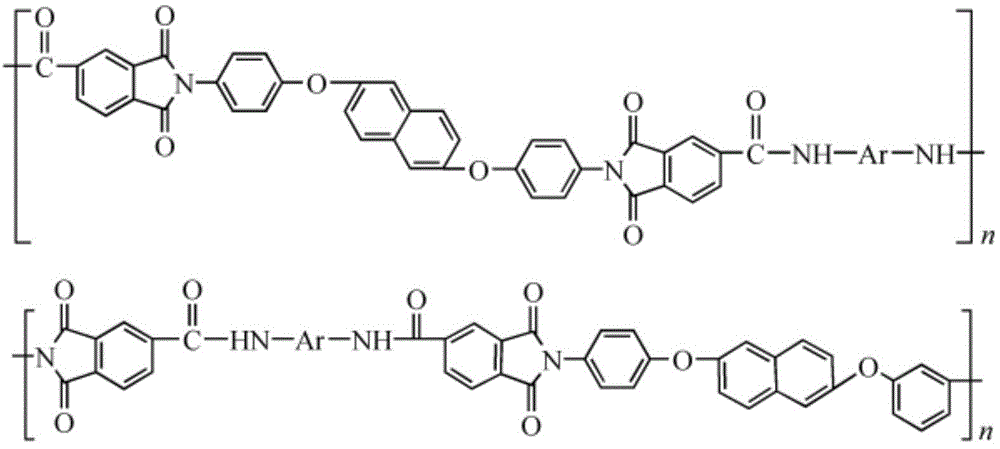Low-melt-viscosity thermoplastic polyimide material and 3D printing moulding method thereof
A polyimide and monomer technology, applied in the field of 3D printing molding materials, can solve the problems of few types of polymers, low temperature resistance, low product strength, etc. Strong knot and excellent effect
- Summary
- Abstract
- Description
- Claims
- Application Information
AI Technical Summary
Problems solved by technology
Method used
Image
Examples
Embodiment 1
[0054] A low-melt viscosity thermoplastic polyimide compound is synthesized as follows: first, 1,4-bis(4-amino-2-trifluoromethyl)benzene and an appropriate amount of NMP are added to the reaction system until it is completely dissolved Then add 2,3,3',4'-diphenyl ether tetra-acid dianhydride and end-capping agent phenylacetylene phthalic anhydride, react for 10 hours, add excess acetic anhydride and triethylamine for chemical imidization, react for another 3 hours, and The above solution was submerged in a mixed solvent of ethanol and water, and a yellow powder was obtained after filtration, washing and vacuum heat treatment.
[0055] Furthermore, a 3D printing molding method of a low-melt viscosity thermoplastic polyimide material is as follows:
[0056] (1) According to the set space spray forming sequence, the system model of the workpiece is provided through computer-aided (CAD) design. Through the system model and the forming machine data exchange interface program, the ...
Embodiment 2
[0064] A low melt viscosity thermoplastic polyimide compound is synthesized as follows: first add 2,2'-bistrifluoromethyl-4,4'-biphenylenediamine and an appropriate amount of DMAc to the reaction system, and wait for After complete dissolution, add 3,3',4,4'-diphenyl ether tetra-acid dianhydride and end-capping agent phthalic anhydride. After 10 hours of reaction, add excess acetic anhydride and triethylamine for chemical imidization, and then After reacting for 3 hours, the above solution was immersed in a mixed solvent of ethanol and water, and a yellow powder was obtained after filtration, washing and vacuum heat treatment.
[0065] Furthermore, a 3D printing molding method of a low-melt viscosity thermoplastic polyimide material is as follows:
[0066] (1) According to the set space spray forming sequence, the system model of the workpiece is provided through computer-aided (CAD) design. Through the system model and the forming machine data exchange interface program, the...
Embodiment 3
[0074] A low-melt viscosity thermoplastic polyimide compound is synthesized as follows: first add 4,4'-ammonia-2,2'-methyl-1,1'-biphenyl and an appropriate amount of DMF to the reaction system, After it is completely dissolved, add 2,3,3',4'-biphenyltetracarboxylic dianhydride and end-capping agent 5-norbornene-2,3-dianhydride, and add excess acetic anhydride and triethylene dianhydride after 10 hours of reaction The amine was subjected to chemical imidization, and then reacted for 3 hours. The above solution was immersed in a mixed solvent of ethanol and water, and a yellow powder was obtained after filtration, washing and vacuum heat treatment.
[0075] Furthermore, a 3D printing molding method of a low-melt viscosity thermoplastic polyimide material is as follows:
[0076] (1) According to the set space spray forming sequence, the system model of the workpiece is provided through computer-aided (CAD) design. Through the system model and the forming machine data exchange in...
PUM
| Property | Measurement | Unit |
|---|---|---|
| tensile strength | aaaaa | aaaaa |
| bending strength | aaaaa | aaaaa |
| heat deflection temperature | aaaaa | aaaaa |
Abstract
Description
Claims
Application Information
 Login to View More
Login to View More - Generate Ideas
- Intellectual Property
- Life Sciences
- Materials
- Tech Scout
- Unparalleled Data Quality
- Higher Quality Content
- 60% Fewer Hallucinations
Browse by: Latest US Patents, China's latest patents, Technical Efficacy Thesaurus, Application Domain, Technology Topic, Popular Technical Reports.
© 2025 PatSnap. All rights reserved.Legal|Privacy policy|Modern Slavery Act Transparency Statement|Sitemap|About US| Contact US: help@patsnap.com



